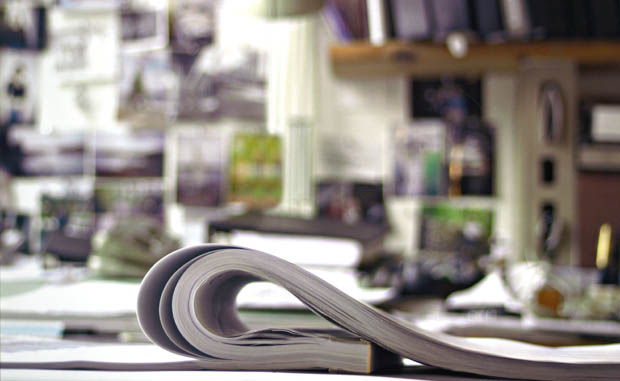A peek into our CA workflow.

Goals
- Efficiency.
- A paperless process, minimizing the heavy lifting of organizing stuff, and opening up desk space and head space for focusing on the task at hand. Light and smart is the attitude, pdf is the format, Submittal Exchange (or something like it) is the tool.
- Keeping documents in the present tense. Carefully recording, in real time, construction changes in documents. Printing fresh hard-copy with each edit, and folding back into the set.
- Religious logging of document arrival and departure times.
- Planning for Record Document requirements at the conclusion of construction.
- Clarity and simplicity for us, and for our builder partners.
Ground Rules
- Paper we insist on:
- a post-bound full-size, or better yet, a half-size set of the Drawings, annotated in red pencil, and protected top and bottom so it survives twelve-plus months of daily handling.
- a loose-leaf copy of the Project Manual, also annotated in red pencil as required.
- A binder or digital folder for RFI’s and responses, with backup, sequentially numbered. The RFI log is the top sheet.
- Another binder or digital folder for ASI’s and responses, with backup, sequentially numbered. The ASI log is the top sheet.
- A date and time stamp for all material received by the office – this is the office manager’s job.
- A log of contractual submittals for arrival, departure and action dates – this is the CA manager’s job.
If the project is large enough, Submittal Exchange will reduce the administrative load of items 2 through 5 above.
Changes to Drawings
- Edit drawings, or create new drawings, directly within the project model – create a new layout sheet as required.
- SK drawings are new 8511 layout snapshots of “original” material on full-size sheets.
- SK’s are numbered sequentially.
- Carefully and accurately cloud the new information – we need to be able to tell exactly what changed, so do this with some accuracy.
- Append two tags to the new clouded information: revision delta number, and associated process document number (RFI or addenda number, etc.). If the change is minor, or otherwise not incorporated officially into an RFI or Change Order, make a note of that.
- If you are issuing an SK – the SK will have its own date. If you are revising a previously-issued sheet, change the manual date on the sheet to the new date of issue (the official sheet date should not be an auto-entered print date).
Revision Numbers
- We only change a revision number when a new edition of the condocs are issued. In practice, this means Revision 1 = bid addenda, Revision 2 = final negotiated contract, and Revision 3 = all the process change orders at the conclusion of the CA phase.
- Place document revision clouds and associated tags on a unique layer corresponding to the revision number.
- Update the layer combination of the final construction document output with the appropriate revision layer, using the annotation pen, cloud line type, or one of the revision cloud objects.
Communication
- SK’s are the vehicle. To repeat: the SK layout is manually dated, and the drawing does not auto-update. SK’s are static snapshots by design.
- 90% of the time the SK is a standard AC layout-with-drawing, but occasionally the SK will not be generated from within AC – a scan, an annotated photograph, etc.
- Therefore, the only SK in the SK layout subset is the last SK produced. The authoritative log is the sequenced series of PDF’s in the server project folder. (ArchiCAD is by design a dynamic present-tense environment – we choose not to use it counter-productively as a filing cabinet to track static non-dynamic data such an an issued SK drawing.)
- Create a PDF publisher directly to the project folder containing all the PDF SK drawings.
- Pull needed SK’s from this project folder.
RFI, ASI, Proposal Requests, CCD, SK catalog, and so forth
- Paperless: create PDF versions of each document type, including the relevant back-up material.
- Keep each of these document types as required for each project in their own folder on the server.
- All these documents are sequentially numbered for easy retrieval.
Submittals and Samples
- See Goal #2 above.
- Coordinate carefully with the contractor’s submittal schedule.
- In the spirit of keeping things in the present tense, aim to keep only current action items out in the studio. Determine what the Owner needs for their records – and move submittals and samples off your desk and out of the office as quickly as possible.
- Coordinate with our record-retentions policy.
Changes to Specs
- The project manual is in a three-ring binder at your desk.
- Cloud and annotate specification changes by hand just as you would drawings.
- In the original specification document, don’t delete changed text, rather strikeout the deleted items. Note the changes and additions in bold red. Follow both deletions and additions by appropriate [tags] in brackets, referencing the revision number and date.
- Insert the revised page into the Project Manual.
STAYING CURRENT
- Once a week, or more frequently as required, save the full, updated, current set in PDF format, as separate sheets, into a folder called “Current Documents” to Output | Current. Set up a single-click project publisher to do this.